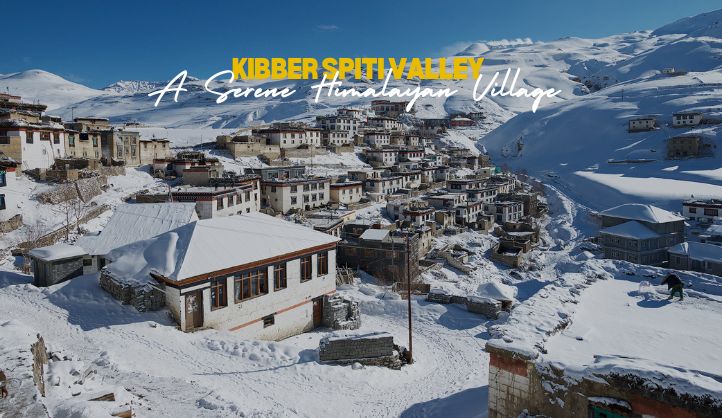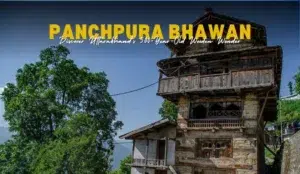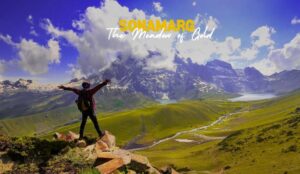Kibber is a picturesque village in the Spiti Valley of Himachal Pradesh, India. Situated at an altitude of around 4,200 meters (13,780 feet), Kibber is one of the highest villages in the world that is connected by a motorable road. The village is a part of the Kaza sub-division and is located about 19 kilometers from Kaza, the main town in the Spiti Valley. Kibber offers stunning views of snow-capped peaks, traditional mud houses, and a tranquil atmosphere, making it a haven for travelers seeking to experience the raw beauty of the Himalayan landscape.
Local Attractions
- Natural Beauty: Surrounded by barren, rugged mountains, Kibber is a visual treat for nature lovers and photographers. The village is in a high-altitude desert, giving it a unique charm. The stark contrast between the brown hills and the blue sky makes it one of the most scenic spots in Spiti Valley.
- Wildlife Sanctuary: Kibber is located near the Kibber Wildlife Sanctuary, which is a rich habitat for wildlife, including the snow leopard, Himalayan blue sheep, and ibex. The sanctuary is known for its diverse flora and fauna, making it a prime spot for wildlife enthusiasts.
- Cultural Heritage: The village is home to the Kibber Monastery, which is an important Buddhist site in the region. The monastery is perched on a hill, providing a spectacular view of the surrounding area. The village itself maintains its traditional Tibetan culture, with its ancient houses, vibrant prayer flags, and Buddhist stupas.
- Trekking and Adventure: Kibber serves as a base for trekking and adventure enthusiasts. Numerous trekking routes begin from here, including the trek to the nearby villages of Langza and Hikkim. The region also attracts those interested in mountaineering and camping.
- Isolation and Peace: Kibber’s remote location, coupled with its minimal population, makes it a perfect place for those looking for peace and isolation. The village’s serene environment, clear skies, and crisp mountain air offer a break from the chaos of urban life.
- Climate: The weather in Kibber can be extreme, with cold winters and pleasant summers. During the winter months, temperatures can drop to as low as -20°C, while summer brings moderate warmth. The region is often covered in snow from November to March, making it a winter wonderland.
How to Reach Kibber
Kibber is accessible by road from Kaza, which is connected to Manali via the Kunzum Pass. The journey to Kibber involves traversing rough, winding roads, which adds to the adventure of reaching this remote village. The best time to visit Kibber is during the summer months (May to October), as the roads are passable and the weather is more favorable.
Best Time to Visit
The best time to visit Kibber is between May and October, when the weather is more accommodating, and the roads are clear of snow. Winter visits can be challenging due to heavy snowfall and freezing temperatures but attract those keen on experiencing a snow-covered landscape.
Local Culture and Lifestyle
The people of Kibber are primarily Buddhist, and their lives revolve around the teachings of Tibetan Buddhism. The village is rich in cultural heritage, with ancient monasteries and stupas scattered throughout. The Kibber Monastery, also known as Ki Gompa, is one of the most important monasteries in the Spiti Valley. The monastery has a rich history, dating back to the 14th century, and is home to many monks who follow Tibetan Buddhist traditions.
In addition to the monastery, the village hosts several festivals throughout the year, including Losar, the Tibetan New Year, which is celebrated with dances, prayers, and offerings. During this time, the locals wear traditional attire, and there is a lot of singing, dancing, and festive cheer. Visitors to Kibber can experience the warmth of Tibetan hospitality and may even have the chance to participate in some of these cultural celebrations.
The lifestyle in Kibber is simple and revolves around agriculture and animal husbandry. The villagers grow crops like barley, peas, and potatoes, and their livestock includes yaks, sheep, and goats. The villagers are known for their resourcefulness, adapting to the harsh conditions of the high-altitude desert environment.
Nearby Places to Explore from Kibber
Kibber, nestled in the Spiti Valley, is surrounded by some stunning locations that offer breathtaking landscapes, rich cultural experiences, and exciting adventure opportunities. Here are a few nearby places worth exploring:
1. Kaza
Kaza is the main town of Spiti Valley and serves as a gateway to the region. It is the administrative headquarters of the valley and offers various amenities like accommodation, restaurants, and markets. Kaza is famous for its vibrant Tibetan culture, monasteries, and the beautiful Pin Valley National Park nearby.
2. Chicham Bridge
The Chicham Bridge is one of the highest suspension bridges in Asia, connecting the village of Chicham to Kibber. It spans a deep gorge, offering stunning views of the rugged landscape below. Walking across the bridge provides a thrilling experience, and it’s a great spot for photography.
3. Langza
Langza is a charming village known for its panoramic views of the Himalayan peaks, including the famous Chau Chau Kang Nilda Peak. The village is dotted with traditional mud houses and is known for its ancient Buddhist monastery. Langza is also famous for fossil hunting, as the area has an abundance of ancient marine fossils.
4. Hikkim
Hikkim is another high-altitude village located close to Kibber. It is known for housing one of the highest post offices in the world. A visit to Hikkim allows you to send postcards from this remote location, offering a unique experience for visitors. The village is surrounded by spectacular landscapes and offers a peaceful, rural atmosphere.
5. Key Monastery
Key Monastery is one of the most significant Tibetan Buddhist monasteries in Spiti Valley. Located on a hilltop near Kibber, the monastery is home to monks and is an important center for Buddhist learning and meditation. The monastery’s architecture is remarkable, with white walls and intricate designs, and it offers sweeping views of the valley.
6. Pin Valley National Park
Located south of Kaza, the Pin Valley National Park is known for its incredible biodiversity and rugged terrain. It is home to rare species like the snow leopard, the Himalayan ibex, and the Tibetan wolf. The park offers various trekking opportunities and is a haven for wildlife enthusiasts and photographers.
7. Tashigang
Tashigang is a small, serene village located very close to Kibber. It is often considered the highest motorable village in the Spiti Valley. Tashigang offers a quiet atmosphere and beautiful views of the surrounding mountains. It is ideal for trekkers looking for a more off-the-beaten-path experience.
8. Dhankar Monastery and Fort
Dhankar Monastery is perched on a cliff and offers stunning views of the valley below. The monastery is known for its unique architecture and its position at the junction of the Spiti and Pin Rivers. The Dhankar Fort, which lies near the monastery, has historical significance and provides panoramic views of the entire region.
Conclusion
Kibber is a mesmerizing destination that offers not only natural beauty and adventure but also a peek into the Tibetan Buddhist way of life. Whether you’re a nature lover, a wildlife enthusiast, or someone seeking peace in the mountains It is a must-visit location for anyone traveling to the Spiti Valley. The village’s tranquil charm, scenic views, and unique culture make it an unforgettable place to experience the beauty of the Himalayas.
FAQs About Kibber
What is the best time to visit Kibber?
The best time to visit Kibber is between May and October when the weather is more favorable and the roads are clear of snow. Winters (November to March) are extremely cold with heavy snowfall, making it more challenging to access the region. However, winter visits are ideal for those looking to experience snow-covered landscapes.
How do I reach Kibber?
Kibber is accessible by road from Kaza, which is the nearest major town. You can reach Kaza from Manali via the Kunzum Pass (open from May to October). From Kaza, it takes about 45 minutes. The roads to Kibber are rough, so it’s advisable to travel by a sturdy vehicle or hire a local driver familiar with the terrain.
Is Kibber a safe destination for tourists?
Yes, It is considered safe for tourists, although it is a remote village. The region is peaceful and welcoming, with locals practicing traditional Tibetan culture. However, due to its high altitude, travelers should be prepared for the thin air and take necessary precautions for altitude sickness.
What is the altitude of Kibber?
It is located at an altitude of approximately 4,200 meters (13,780 feet) above sea level, making it one of the highest villages in the world. The high altitude can affect some visitors, so it’s essential to acclimatize properly before engaging in any physical activities.
What are the main attractions in Kibber?
Some of the key attractions in and around it include:
Kibber Monastery: A Buddhist monastery offering stunning views and a chance to experience Tibetan culture.
Kibber Wildlife Sanctuary: A haven for wildlife, including snow leopards, ibex, and Himalayan blue sheep.
Chicham Bridge: One of Asia’s highest suspension bridges offering a thrilling experience.
Trekking routes: Kibber serves as a base for treks to Langza, Hikkim, and the Pin Valley National Park.
Are there accommodations available in Kibber?
It is a small village, and accommodations are relatively basic, often in the form of guesthouses or homestays. The options are limited, so it’s recommended to book in advance, especially during peak tourist seasons. For a more comfortable stay, you can find better facilities in nearby towns like Kaza.





